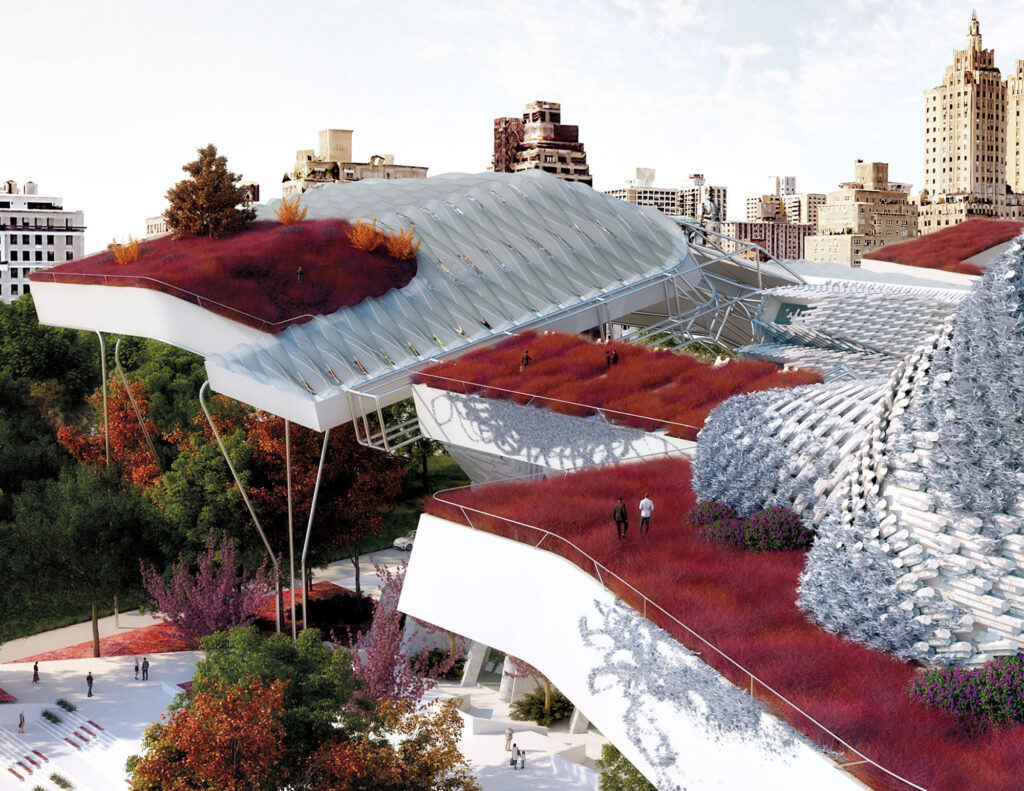
April 28, 2022
Surviving and Thriving
At press time, the United Nations estimates that two million people have fled the war in Ukraine. The European Union predicts that the total number of refugees could climb to seven million, which would make it comparable to the crises created by the civil war in Syria and the failed revolution in Venezuela. As the world once again debates who gets let in and who gets left out, I wonder why there isn’t an institution to succor refugees independent of parochial politics.
2022 Metropolis Future100 honoree Danny Ortega and his classmate Anna Lim—both graduate architecture students at the University of Pennsylvania’s Weitzman School of Design—have imagined just such a space in their No Nation Embassy (“Future100: Students Explore Futuristic Building Technologies” and this month’s cover). By dematerializing building elements and creating moments of surprise, they seem to ask if architecture can better represent human rights if it eschews the marble-and-glass machismo of nationalism.
This is the kind of provocation offered over and over again by this year’s Metropolis Future100, the top North American architecture and interior design graduates of the class of 2022.
Two hundred and thirty-seven students were nominated for this year’s list by their instructors and mentors. In selecting the final 100, Metropolis’s reviewers—SANDOW Design Group EVP and design futurist AJ Paron, executive editor Sam Lubell, editorial project manager Lauren Volker, and I—were especially sensitive to the fact that this cohort had a hybrid or virtual education unlike any generation before them.
But rather than have to make concessions for the disruptions these students have endured in the past two years, we found ourselves marveling at their ability to channel the difficult experience into design solutions. A number of students grasped architecture’s role in helping people deal with loss—University of Pennsylvania graduate students Dario Sabidussi and Yuxuan Xiong (“Future100: Students Design for Death”) showed how this new generation is rethinking memorials and funerary facilities. Antidotes to social isolation abound in this year’s portfolios as well, with graduates designing community spaces that celebrate diversity rather than flatten people’s differences—see Drexel University student Pooja Kalavagunta’s Shosh Center for Afghan Refugees or Kent State University student Sombre Carleton’ s ABA Autism Center (“Future100: Four Students Design to Build Community”).
These brave young architects and interior designers deserve your support and encouragement as they embark on their careers. We invite you to get to know them in the pages of this issue and on metropolismag.com/future100.
Our focus on learning continues with a series of stories on design for education. From elementary schools (“5 Schools Show Creative Design Supports Creative Learning”) to higher education campuses (“Ge Hekai Hall at Wenzhou-Kean University Unites Students and Disciplines“), these buildings are sites for experimentation in both architecture and pedagogy. Here’s hoping they continue to nurture the courage and ingenuity we will need to thrive in the face of mounting ecological, political, and social challenges.
Top: Danny Ortega’s No Nation Embassy proposal aims to honor the history of Seneca Village, a largely African-American community that was destroyed to create Manhattan’s Central Park in 1857. The student writes, “With the ideology of anti-empiricism, this remake of Seneca Village accepts all as citizens with equal rights,” and acts as a safe space for undocumented immigrants and refugees. COURTESY DANNY OERTEGA
Would you like to comment on this article? Send your thoughts to: [email protected]
Related
Products
The 2022 Role Models Contest Marries Innovative Material Design with Practical Application
Designed to disrupt, the global student competition yields its most viable material solutions yet.
Viewpoints
Students Lead the Way to A Post-Industrial Future at the Saint-Étienne Biennale
Exploring everything from automobiles to the COVID-19 lockdowns, the biennale explores the post-industrial possibilities through the theme of “Bifurcation.”
Profiles
Mariam Kamara Could Profoundly Change Design Pedagogy Everywhere
The Niger-based architect Mariam Kamara’s rapidly growing practice informs a series of lectures she has delivered recently at MIT, Columbia University GSAPP, the African Futures Institute in Ghana, and Harvard GSD.




